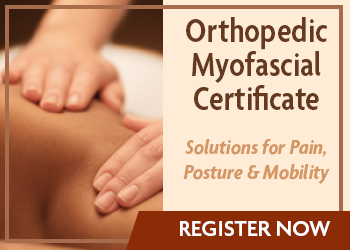What You'll Learn
Significance of Connective Tissue & Neuromuscular Systems in Management of Restrictive Mobility Impairments
Myofascial Release/Soft Tissue Mobilization Fundamentals for Function
Anatomy and Function of Fascia in Normal and Pathological Conditions
Importance of palpation sensitivity, grading depth of pressure, stages of release
Differential Diagnosis of Fascial Impairment: Myofascial Pain and Fibromyalgia
Identify fascial mobility impairments using posture and palpation exams
Facilitate releases with integrative interventions, breathing, movement
Objective documentation of trigger points, scar tissue, mobility impairments, and functional change
Using functional outcomes measures effectively for insurance reimbursement
Identify Mobility Impairments Using Posture, Palpation, and Motion Testing
Soft Tissue Mobility Assessment – How to Listen to What the Body is Saying
Myofascial assessment- observation and motion testing for restrictions
Develop palpatory skills, proper tissue pressure, graded touch, and timing
Techniques to Remodel Fascia, Relieve Pain, and Increase Functional Mobility
Instrument-Assisted Soft Tissue Management Techniques
Cupping: Use of negative pressure dry cupping suction cups - Baguan
Scraping- use of shaped tools to remodel adhesions- Guasha
Blades, rollers, balls, and shaped tools to remodel fascia
When to use your hands vs. instrument-assisted release
Myofascial Distraction Techniques and Soft Tissue Management for Specific Regions
Arm and leg distraction
PNF/ Muscle Energy and STM combined
Respiratory and transverse fascial diaphragm
Iliopsoas
TMJ Release
Suboccipital Inhibition Release
Trigger Point Release Fast ‘n Easy
Ischemic Compression and Reflex Inhibition to Ease Painful Muscle Tension
Etiology and physiology of trigger points, assessment, imaging, research evidence
Trigger point pain presentation/referral patterns
Interventions to Manage Painful Trigger Points
Integrative Neuromuscular Inhibition Technique
Positional Release (Strain-Counterstrain) with application for mobility, strength, and function
Neuromuscular basis for positional release technique (PRT)/Strain-counterstrain (SCS)
Role of Trigger Points in Movement Impairments
Demonstration of PRT interventions: Cervical, shoulder, lumbar, hip, knee
Home Program Design using PRT






